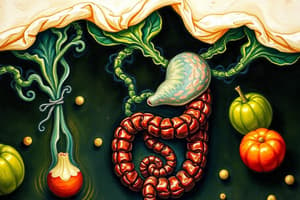Podcast
Questions and Answers
Which of the following processes is NOT involved in nutrient absorption?
Which of the following processes is NOT involved in nutrient absorption?
What is the primary function of lipase in the digestive process?
What is the primary function of lipase in the digestive process?
Which of the following statements accurately describes the role of cholecystokinin (CCK) in digestion?
Which of the following statements accurately describes the role of cholecystokinin (CCK) in digestion?
What is the primary function of the large intestine in the digestive process?
What is the primary function of the large intestine in the digestive process?
Signup and view all the answers
Which of the following is NOT a role of the liver in the digestion and absorption process?
Which of the following is NOT a role of the liver in the digestion and absorption process?
Signup and view all the answers
Signup and view all the answers
Flashcards
Ingestion and Digestion
Ingestion and Digestion
The process of taking in food and breaking it down into nutrients.
Trypsin
Trypsin
An enzyme that breaks down proteins, produced in the pancreas.
Passive Diffusion
Passive Diffusion
Movement of nutrients from high to low concentration without energy.
Small Intestine Functions
Small Intestine Functions
Signup and view all the flashcards
Liver's Role
Liver's Role
Signup and view all the flashcards
Study Notes
Ingestion and Digestion
- Ingestion and digestion involve the process of taking in food and breaking it down into simpler substances the body can use
- Secretions and motility play a key role in this process
Taste, Smell, and Mastication
- Taste and smell influence the digestive process
- Mastication (chewing) is crucial in breaking down food for chemical digestion
Digestive Enzymes and Secretions
- Trypsin: An enzyme that aids in protein digestion, produced in the pancreas
- Cholecystokinin (CCK): Hormone that stimulates release of digestive enzymes and bile
- Bile: Produced in the liver, stored in the gallbladder, crucial for fat digestion
- Lipase: An enzyme that breaks down fats, produced in the pancreas
Nutrient Absorption Mechanisms
-
Passive diffusion: Movement of substances across a membrane without energy input
-
Osmosis: Movement of water across a membrane
-
Facilitated diffusion: Movement of substances across a membrane with help of carrier proteins
-
Active transport: Movement of substances against a concentration gradient requiring energy input
-
Pinocytosis: Cellular uptake of fluids or small particles
-
Nutrient absorption occurs primarily in the small intestine
Intestine Functions
- Small intestine: Major site of nutrient absorption
- Large intestine: Absorbs water and electrolytes, forms feces
Gas Production
- The process of gas production in the digestive system is not explicitly defined in these objectives.
Metabolism
- Metabolism is the sum of all chemical reactions in the body that build up or break down substances
- It's essential for maintaining life functions
Macronutrient Metabolism
- Carbohydrate metabolism: Breakdown and utilization of carbohydrates for energy
- Lipid metabolism: Breakdown and utilization of fats for energy and other functions
- Protein metabolism: Breakdown and synthesis of proteins for various bodily functions
Absorption Processes
- Water, proteins, fats, and carbohydrates are absorbed by different mechanisms in the digestive tract
- Specific locations of absorption are not specified in the learning objectives
Enzymes
- Lipase: Breaks down fats
- Amylase: Breaks down carbohydrates
Liver's Role in Digestion and Absorption
- The liver plays a critical role in digestion and absorption, particularly in fat digestion through bile production.
Studying That Suits You
Use AI to generate personalized quizzes and flashcards to suit your learning preferences.
Description
This quiz explores the processes of ingestion, digestion, and nutrient absorption in the human digestive system. It covers the roles of digestive enzymes, secretions, and mechanisms such as passive diffusion and osmosis. Test your knowledge on how taste, smell, and mastication contribute to digestion.




